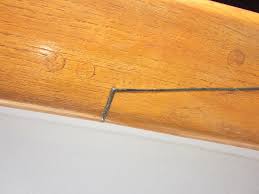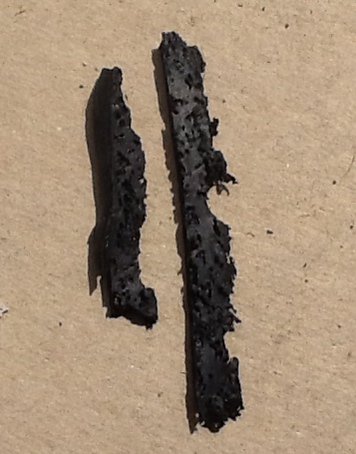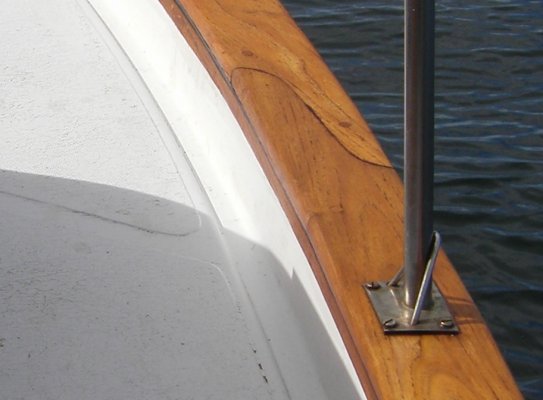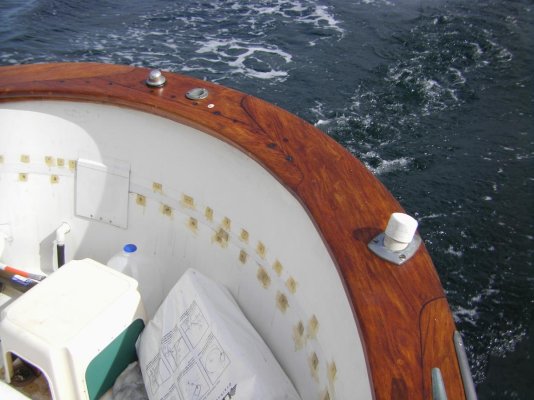You are using an out of date browser. It may not display this or other websites correctly.
You should upgrade or use an alternative browser.
You should upgrade or use an alternative browser.
blistering Cap rail joints
- Thread starter deepsix
- Start date
The friendliest place on the web for anyone who enjoys boating.
If you have answers, please help by responding to the unanswered posts.
If you have answers, please help by responding to the unanswered posts.
hmason
Guru
- Joined
- Aug 9, 2013
- Messages
- 2,764
- Location
- USA
- Vessel Name
- Lucky Lucky
- Vessel Make
- Pacific Mariner 65
After owning 2 Grand Banks over an 18 year span, I have not found any trick to prevent moisture getting into the joints. What I did discover is that the process of covering every piece of beautiful bright work with canvas does nothing to prolong the life of the finish. I have found that leaving it uncovered allows moisture to evaporate quickly and the finish, FWIW, lasts longer for me. The day I threw all those yards of canvas into th dumpster and relieved myself of that arduous task was a happy boating day. In case you are wondering, we are full time cruisers and our bright work is exposed to sun year round.
Howard
Howard
RT Firefly
Enigma
Greetings,
Mr. d. I think enlarging the joint and filling with caulk may help.

Mr. Larry M's picture...
Mr. d. I think enlarging the joint and filling with caulk may help.
Mr. Larry M's picture...
Nomad Willy
Guru
I suspect the best approach is to provide the joints w a very flexable coating and to make the joint wide enough to flex gracefully w/o breaking the adhesion of the caulking in the seam or the coating over it.
What I do to accomplish the above is to varnish our cap rail w a high oil more flexable varnish that will resist strongly the tendency to crack or break and allow water to reach the wood, cause swelling, mildew and eventially rot. And of course the water promotes the breakdown of the adhesion of the caulk to the faces of the joint and then the water goes deep into the joint. Not good.
What I do to accomplish the above is to varnish our cap rail w a high oil more flexable varnish that will resist strongly the tendency to crack or break and allow water to reach the wood, cause swelling, mildew and eventially rot. And of course the water promotes the breakdown of the adhesion of the caulk to the faces of the joint and then the water goes deep into the joint. Not good.
Last edited:
sunchaser
Guru
- Joined
- Apr 9, 2008
- Messages
- 10,195
- Location
- usa
- Vessel Name
- sunchaser V
- Vessel Make
- DeFever 48 (sold)
The most successful joints I have seen are those that are zig zagged, tightly caulked and about 1/4 minimum wide. Like most DeFevers. This allows normal minor heat/cold flexing without leaking. Some very high end vessels do straight joints with poor expected results. Also, the cap rail needs a tight bead of caulk underneath on both sides or moisture will wick up. Don't forget to rebed any screws that go into the cap rail, they leak over time too.
On some vessels nothing works well to keep varnish looking good as the hull underneath or cap rail/hull joining technique is too flimsy and is working all the time against the cap rail and loosening up varnish. In this case natural and lightly oiled teak may be the best approach.
On some vessels nothing works well to keep varnish looking good as the hull underneath or cap rail/hull joining technique is too flimsy and is working all the time against the cap rail and loosening up varnish. In this case natural and lightly oiled teak may be the best approach.
Nomad Willy
Guru
My caprail joints are curved at the ends. I wonder how they cut then so they fit? And I wonder if the curve is a benefit to the seam re flexing and working? Or if it just looks better to some.
The cockpit mess? Working on that today .. painting even.
The cockpit mess? Working on that today .. painting even.
Attachments
Unlike Hmason, we have found that covers on external teak extend the life of a bright finish by a factor of years. Many years. Also, we bailed on varnish as an exterior bright finish some 15 years ago and switched to Bristol which in this climate outlasts varnish by a good five or six years assuming the finish is applied properly in the first place.
The key to keeping finish from lifting is proper bedding of the teak, be it against a surface or in a joint.
The key to keeping finish from lifting is proper bedding of the teak, be it against a surface or in a joint.
River Cruiser
Guru
- Joined
- Jan 25, 2013
- Messages
- 1,357
- Location
- US
- Vessel Name
- Northern Lights II
- Vessel Make
- Bayliner 3870
BoatLife caulk works very well on my caprail joints.
Nomad Willy
Guru
RC I think that Boatlife is formulated for teak.
Hard to get anything to stick to something oily.
Hard to get anything to stick to something oily.
Capt.Bill11
Guru
The only problem with using the TDS caulk is I don't believe it comes in small squeeze tubes.
As noted Lifecaulk or 5200 works just fine.
As noted Lifecaulk or 5200 works just fine.
The only problem with using the TDS caulk is I don't believe it comes in small squeeze tubes.
You're correct, I don't believe it does. However we've been taught a technique that keeps TDS "good" in the tube for a long time after it's been opened and used in a caulking gun. And since we have a 42 year old teak deck we tend to have TDS on the boat a fair amount of the time.
But you're right, it would not be worth buying a tube of TDS just to caulk a few rail joints. It ain't cheap stuff......
JDCAVE
Guru
- Joined
- Apr 3, 2011
- Messages
- 2,905
- Location
- Canada
- Vessel Name
- Phoenix Hunter
- Vessel Make
- Kadey Krogen 42 (1985)
I'm going through this now. I refinished my caprail last spring and the finish has failed at the joints. S-3 Maritime does the commissioning for the new build kadey Krogens and they now caulk all the joints on the caprail. I have an email in to them but I want to report my recent failure. Yesterday, after considerable perpetration, I filled the joints with Sikaflex 291 and was very pleased with the way it looked...until 3 hours after it cured and I has Sikaflex soufflé! The Sikaflex had raised up considerably above the joint. I pulled the material out of one joint and it looks like closed cell neoprene. This looks to me like the product gases on curing.

I'm now looking into TDS Teak Deck Caulking but am unsure if I can source this product up here. BTW, as Sunchaser mentions, my joints are zigzagged.
Jim
Sent from my iPad using Trawler Forum

I'm now looking into TDS Teak Deck Caulking but am unsure if I can source this product up here. BTW, as Sunchaser mentions, my joints are zigzagged.
Jim
Sent from my iPad using Trawler Forum
Last edited:
Try Fisheries Supply in Seattle for the TDS. They ship all over the world.
TDS is the best deck seam sealant on the planet. I would think it would be ideal for cap and handrail joint seams, too. When we have time to redo all the rails properly on our PNW boat we'll widen the existing joint gaps and use TDS to fill them.
I did this a number of years ago to the handrail gate on our stern rail. I refinished the teak gate and then sealed the joints at the bronze hardware that goes on at each end of the gate. It's been years since I did this and there has been no finish (Bristol) lifting at the joints as there has been on the other gates.
I did this a number of years ago to the handrail gate on our stern rail. I refinished the teak gate and then sealed the joints at the bronze hardware that goes on at each end of the gate. It's been years since I did this and there has been no finish (Bristol) lifting at the joints as there has been on the other gates.
Last edited:
JDCAVE
Guru
- Joined
- Apr 3, 2011
- Messages
- 2,905
- Location
- Canada
- Vessel Name
- Phoenix Hunter
- Vessel Make
- Kadey Krogen 42 (1985)
Western Marine carries it. Going to get it now. I got the Boatlife product at the local store but based on what others have said, I will get the TDS product instead. Thanks guys!
Jim
Sent from my iPad using Trawler Forum
Jim
Sent from my iPad using Trawler Forum
Note that TDS is not inexpensive and an unopened tube has a one-year shelf life. I have had good luck after using part of a tube to cut the finger off a thin nylon (surgeon's) glove, put it over the nozzle with a little slack at the top, tape it tightly around the nozzle with electrical tape, and then use the gun to fill the top of the finger. This keeps air out of the tube pretty effectively. When I want to use the tube again I remove the glove and the glob of sealant in the finger and the rest of the material is good to go.
The life of the material in the tube is still shortened but I've had a tube be good to use even after two or three months stored like this.
The life of the material in the tube is still shortened but I've had a tube be good to use even after two or three months stored like this.
JDCAVE
Guru
- Joined
- Apr 3, 2011
- Messages
- 2,905
- Location
- Canada
- Vessel Name
- Phoenix Hunter
- Vessel Make
- Kadey Krogen 42 (1985)
Note that TDS is not inexpensive...
$20 Cdn.
Quite frankly, I would have rather paid $100 and used it in the first place rather than go through the process of having to clean the Sikaflex out of the joints and recaulk!
Jim
Sent from my iPad using Trawler Forum
$20 Cdn.
Is that for a full-size calking gun tube or a smaller tube (I've never seen anything smaller than the full-size gun tube).
JDCAVE
Guru
- Joined
- Apr 3, 2011
- Messages
- 2,905
- Location
- Canada
- Vessel Name
- Phoenix Hunter
- Vessel Make
- Kadey Krogen 42 (1985)
Well, I don't know what I was thinking of. A calking tube of TDS at Fisheries Supply is $13. Maybe I was thinking of Bristol, which is some $60 a kit.
$20 Cdn was for the full size caulking tube. They rip us off up here!
I heard back from S-3 Maritime. He recommends using 3M 4000UV and doing the caulking in two layers with 2 days of curing between layers. After masking, he suggests "squeegying" down the first layer with a small stick or tool and work it to get rid of air bubbles. The second layer is slightly proud of the joint and is trimmed down with a sharp chisel after it is cured. "Bubbles are from out gassing of trapped air, try to avoid leaving any voids by squeezing sealant with putty knife when laying in. Poke with knife if needed to pop uncured bubbles."
The two layer idea seems smart, not sure if I have the talent to cut the 2nd layer with a sharp chisel. I'm NOT Michaelangelo!
I will use the TDS product and do it in two layers as he suggests and see how that goes. It makes sense to me.
Jim
Sent from my iPad using Trawler Forum
Last edited:
Nomad Willy
Guru
Marin,
Does one get surgeons gloves in a hospital?
Wonderful sealing method. I've been trying stuff for years w very little success.
Re the caulking we've been using SikaFlex 291 for many years and had no issues that wer'nt expected. Was going to try the brown BoatLife as they say it's formulated for teak. We generally have the BoatLife around as it's availible in the small toothpaste type tubes so very small amounts can be accessed and the screw thread cap lasts quite a long time. Chris uses it kinda like touch-up paint. More than anything else she puts in in very shallow bung holes. And the brown blends well w the wood. As intended I suppose.
Does one get surgeons gloves in a hospital?
Wonderful sealing method. I've been trying stuff for years w very little success.
Re the caulking we've been using SikaFlex 291 for many years and had no issues that wer'nt expected. Was going to try the brown BoatLife as they say it's formulated for teak. We generally have the BoatLife around as it's availible in the small toothpaste type tubes so very small amounts can be accessed and the screw thread cap lasts quite a long time. Chris uses it kinda like touch-up paint. More than anything else she puts in in very shallow bung holes. And the brown blends well w the wood. As intended I suppose.
Marin,
Does one get surgeons gloves in a hospital?
.
No, I just didn't know how else to describe them. And they aren't nylon--- i don't know why I came up with that one. They're latex. You can buy them in bulk at Costco and hardware stores.
I first learned of their value from the fellow who used to own the BMW shop I used. He wears them to keep his hands clean while working on vehicles. After decades of working on my Land Rover and other vehicles and getting my hands semi-permanently stained with grease and dirty oil and whatnot, I realized what a dummy I'd been. Now I wear them whenever I work on a vehicle, on a job on our boats, and so on.
Last edited:
JDCAVE
Guru
- Joined
- Apr 3, 2011
- Messages
- 2,905
- Location
- Canada
- Vessel Name
- Phoenix Hunter
- Vessel Make
- Kadey Krogen 42 (1985)
I use the vinyl gloves. When I rebedded the pilothouse windows with 3m 4200, I used 8 cartridges of caulk over several months. After a job, I remove the applicator tube, put a used vinyl glove over the aluminum nipple and take a new applicator tube from an unopened tube of caulk and screw it on to the nipple. It completely and tightly holds the vinyl in place. Then it goes into the fridge. That worked very well.
Jim
Sent from my iPad using Trawler Forum
Jim
Sent from my iPad using Trawler Forum
markpierce
Master and Commander
- Joined
- Sep 25, 2010
- Messages
- 12,557
- Location
- USA
- Vessel Name
- Carquinez Coot
- Vessel Make
- penultimate Seahorse Marine Coot hull #6
The few times I've worn latex gloves, they quickly fill with perspiration. How long before super-humidity will harm one's hands?
Forkliftt
Guru
- Joined
- Oct 6, 2007
- Messages
- 2,450
- Location
- USA
- Vessel Name
- KnotDoneYet
- Vessel Make
- 1983 42' Present Sundeck
Nitrile gloves are the way to go. We buy two cases at a time. Mark, you get use to the sweat. I think Auto Zone carries them for around $-6 per box. Thats 32¢ per set up. A hired mechanic will charge you the 4-5 minutes while he washed his hands (X $100 an hour!). It might save you money to keep a box on hand to offer to him ?. Working with wets hands can be tough during the summer, but It's MUCH better on your hands than gear oil, old grease, etc etc
1983 Present 42 Sundeck
Twin Lehman 135's

1983 Present 42 Sundeck
Twin Lehman 135's
Okay, third time's a charm. I just went out and looked at the Costco gloves in the shop in our garage. They are Nitrile Exam gloves. So not nylon, not latex. My hands don't sweat in them and they are thin enough that I can feel evertything I'm doing, even working with little fasteners and such. Sold under Costco's Kirkland house name.
JDCAVE
Guru
- Joined
- Apr 3, 2011
- Messages
- 2,905
- Location
- Canada
- Vessel Name
- Phoenix Hunter
- Vessel Make
- Kadey Krogen 42 (1985)
Thanks Marin for the advice on the TDS product. Definitely superior to the Sikaflex product. I followed the instructions from S-3 Maritime and caulked in two layers, although I suspect that wasn't necessary. It definitely didn't gas at all, unlike the Sikaflex that when cured looked like closed-cell neoprene.
Jim
Sent from my iPad using Trawler Forum
Jim
Sent from my iPad using Trawler Forum



